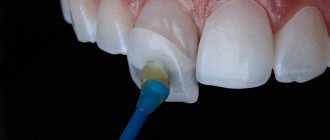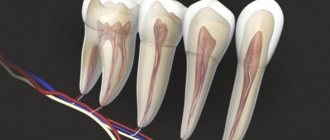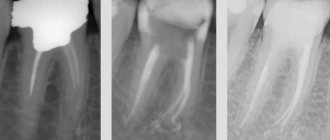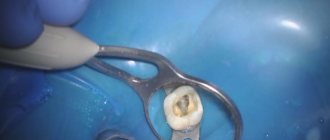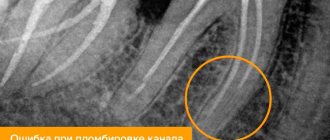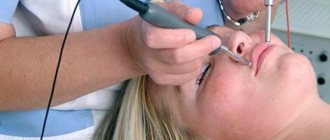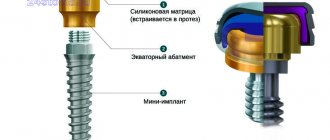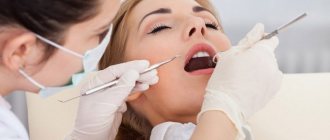When nerve removal is indispensable
In modern dental practice, both complete and partial resection are used. Indications for the procedure:
- deep carious tissue damage;
- chronic pulpitis (including asymptomatic);
- bactericidal infection spread by the apex of the tooth root;
- the presence of an extensive pulp area, the threat of developing periodontitis or transition to periodontitis;
- trauma leading to nerve exposure and tooth destruction;
- the need to correct a medical error;
- the need for prosthetics with low crowns.
Unbearable pain can also be an indication for depulpation.
The dentist will never prescribe such a serious intervention as long as it is possible to save the tooth.
Important
: problematic “eights” when affected by caries, as a rule, are removed. This is due to the location of the “wisdom” teeth at the end of the dentition, which makes cleaning them from plaque and stone and filling the canals very problematic. Indications for removal are also the wrong direction of eruption, displacement of the dentition, malocclusion, and the development of pulpitis.
Why is it important to care for dental implants?
Careful care of artificial teeth is important for the survival of titanium roots. After the implantation of the structures, a restructuring occurs in the bone tissue, and the body adapts to the presence of a foreign body. It is important that nothing interferes with the integration of the implant. Engraftment slows down due to chronic diseases, trophic disorders, and inflammatory changes.
Improper care after fixing the crown creates a risk of periodontal disease. Bacterial plaque accumulates in areas under the crown, which disrupts the balance of beneficial and harmful microflora in the mouth. When the latter predominates, inflammation develops. It passes from the gums to bone tissue with the development of periostitis or peri-implantitis. In these conditions, implant failure is likely.
Patients at risk need to be especially careful, since they have trophic or immune disorders even before the introduction of titanium roots. This negatively affects the healing of implants, slowing down the process. There is already a risk of rejection, but if hygiene rules are violated, it increases significantly. The risk group includes:
- pregnant women;
- patients with diabetes mellitus, low immunity;
- allergy sufferers;
- persons with alcohol, drug, or nicotine addiction;
- people exposed to chronic stress.
What is the dental nerve called?
In dentistry, the dental nerve, or pulp, is a complex structure - an interweaving of nerves and vessels located inside the root and crown of the tooth and responding to external stimuli.
Depulpation allows you to save the damaged tooth, but has negative consequences:
- Since the pulp acts as a barrier to infections, removing the nerve deprives the tooth of the necessary level of blood supply and mineralization, which shortens its “life.”
- A tooth deprived of a nerve loses sensitivity, the enamel becomes more fragile and faded, and the strength of the tooth decreases.
Rules of care after installation of a crown or prosthesis
To clean orthopedic structures (crowns, bridges) on implants, you need to use a non-electric toothbrush, mouthwash, and an oral hygiene device - an irrigator.
Crowns
When restoring lost teeth, crowns can be installed immediately after implantation or after the implantation of an artificial root. Caring for the crown after surgery involves cleaning its surface with a soft brush. The base cannot be vigorously cleaned.
After the implants have healed, care comes down to brushing on all sides, especially in the area between the crown and the gum. This is where plaque and bacteria accumulate. Hygienic treatment is carried out twice a day. Dental floss cannot be used due to the risk of damaging the gums and exposing the titanium root, which can lead to rejection of the material.
Bridges
Orthopedic bridge structures are installed in case of complete or multiple edentia on several implants. Such dentures require more careful care. Superficial cleansing involves the use of a toothbrush and mouthwash. Dirt and food debris from the gums are removed using a monotuft brush or brush, or an irrigator.
Related articles:
- Guarantees of our Center
- Engraftment of implants
- Our advantages
Stages of the depulpation process
- X-ray – necessary to assess the condition of the pulp, the number, length and branching of the canals to be filled.
- Anesthesia - local or complete anesthesia completely covers the issue of pain when removing a nerve (it doesn’t hurt!). At the same time, general anesthesia is used relatively rarely - when treating children, with true dental phobia, etc.
- Installation of a rubber dam - a latex film for insulating a tooth. A modern solution to improve the dentist’s working conditions and protect against the possible spread of microorganisms through saliva.
- The actual removal of the nerve is the excision of tissues affected by caries, opening the pulp chamber and extracting the nerve with a special instrument (pulpoextractor). In modern practice, this is a careful cutting of the pulp without affecting sensitive areas.
- Installation of a temporary filling (for a period of 1-2 weeks).
- Control x-ray.
If the x-ray and the condition of the tooth are satisfactory, after the control period a permanent filling is installed.
Hygiene products at different stages
At each stage of dental restoration, the doctor gives the patient recommendations for care and treatment, recommends devices and gives instructions for use. You cannot ignore the advice of an implantologist, because the engraftment of titanium roots and the service life of the products may depend on this.
Toothbrush
The brush is used for basic cleaning of the oral cavity. Immediately after treatment, only soft brushes can be used. After the implants have healed, the use of medium-hard brushes is allowed. It is important to change the device regularly.
Toothpaste
The implantologist gives recommendations to the patient regarding toothpaste for caring for implants. It should have a soft, uniform consistency, reduce inflammation and fight bacteria. Conventional pastes are not suitable. Some of them are abrasive. They can damage the orthopedic structure. It is better to give preference to medicinal pastes.
Irrigator
The irrigator provides high-quality cleaning of the surface of the teeth, as well as interdental spaces, gum pockets, and the pores of the material from which the prosthesis is made. The device operates on mains power or battery power. The principle of operation is based on the supply of liquid under pressure, due to which it reaches hard-to-reach places. You can use the irrigator only after the implants have completely healed. Implantologists recommend cleaning the oral cavity with clean water, as well as special solutions. In addition to cleaning, the irrigator provides a light massage of soft tissues.
Cleaners
Brushes are small thin brushes of various shapes and lengths. They are designed for manual cleaning of hard-to-reach places (interdental spaces, the inside of the crown). There are cylindrical and cone-shaped brushes. The products are best used to clean the areas between the teeth, as well as the top of the implants at the point of contact with the gums. Curved brushes are suitable for cleaning the inside of bridges.
Dental floss
Flosses can be used only after the gums have completely healed, in consultation with your doctor. Regular dental floss can easily injure soft tissue, so after implantation it is better to use a series designed specifically for this. Such threads consist of a guide tip, sections of spongy and classic dental fiber. They are safe for soft tissues and easily penetrate even the narrowest areas between teeth. Suitable for cleaning the abutment and crown surface.
Depulpation before prosthetic crowns
Depulpation is unconditional if there is serious tooth decay. It is preferable to remove the dental nerve during prosthetics in the following cases:
- The size of the teeth determines the low position of the crown (too small or short teeth);
- The inclination of the prosthetic tooth is from 15°;
- Increased sensitivity of teeth;
- According to aesthetic requirements.
The need to remove the dental nerve during prosthetics is dictated by deep removal of the top layer of dental tissue: if the doctor is not sufficiently qualified, heating or touching the nerve can cause an attack of unbearable pain. However, cases of nerve-sparing crown installation also occur in modern dental practice.
If over time the nerve under the crown becomes bothersome, it is possible to remove the pulp through the top of the crown and fill the hole after removal.
The danger of such a procedure is associated with the risk of complications in the future due to surgery on the exposed dental nerve.
Contraindications
Nimesil is strictly forbidden to be used by patients with a history of:
- hypersensitivity to the action of any of the components of the drug;
- hyperergic reactions caused by non-steroidal anti-inflammatory drugs (bronchospasm, rhinitis, urticaria);
- ulcerative lesions of the gastrointestinal tract;
- tendency to internal bleeding;
- functional failure of the liver or kidneys;
- the presence of an acute infectious process accompanied by a significant increase in body temperature;
- heart failure;
- pregnancy and lactation period;
- age less than 12 years;
- alcohol or drug addiction.
To avoid the development of severe complications in the postoperative period, you should warn the dentist in advance about the presence of any acute and chronic diseases.
Only having all the information about the patient’s health status will the doctor be able to select the optimal analgesic to relieve post-traumatic symptoms.
About dental anesthesia
Standard dental practice is an injection of anesthetic; Taking tablet analgesics before going to the dentist is not recommended, as it leads to a decrease in the effectiveness of anesthesia (usually the effect of an anesthetic injection is 45 minutes). For patients suffering from a fear of injections, it is possible to use paste anesthesia, which has a similar effect.
The choice of anesthesia is up to the dentist; Taking into account the individual pain sensitivity threshold of each patient, the standard dose is sometimes doubled or even tripled. With proper selection of an anesthetic, discomfort during the procedure for the patient is excluded.
After the operation, the patient receives a package of “NB AFTER” medications for treatment at home.
Doctors at our Center instruct each patient after surgery and issue general and individual recommendations. You will find them in printed form in the “NB AFTER” box along with the prescribed medications.
Levin Dmitry Valerievich
Chief physician, Ph.D.
Nutrition rules
It is important to pay close attention to your diet. After surgery, it is not recommended to eat for 2 hours . As time passes, it is permissible to eat warm and soft foods and avoid spicy foods. List of recommendations:
- chew on the opposite side of the sutures;
- before eating, apply Solcoseryl dental adhesive paste to the seams;
- after eating, make oral baths for 2-3 minutes with a solution of “Chlorhexidine”;
- when implanting dental implants, do not eat solid foods that change the position of the restoration stimulators installed along the neck of the implant;
- Limit food that requires active chewing.
Do not use:
- solid foods (apples, cucumbers);
- fibrous meat;
- hot dishes;
- cold dishes;
- spices.
You need to eat soft, easily digestible food of uniform consistency. It is better not to consume berries and purees with crushed seeds.
Lifestyle
Immediately after implantation, the patient should not smoke or drink alcohol. Bad habits have a bad effect on trophic processes and the functioning of the immune system, and negatively affect osseointegration.
In the first days after surgery, it is advisable to sleep on your back or on the side opposite to the implantation site. After tissue fusion, this limitation is removed.
From the first days and during the first month after the operation, the following are prohibited:
- visits to a sauna or bathhouse, hypothermia - weaken the immune system;
- air travel - especially after implantation with simultaneous sinus lift;
- loads - you cannot lift weights, overexert yourself physically or mentally, light physical labor or exercise in the pool is allowed.
If there is pain
Painful sensations when swallowing and opening the mouth are considered normal after dental implantation. The intensity differs for each patient. We focus on the fact that moderate pain, which can be relieved with painkillers, can be considered normal.
You need to contact the coordinator or attending physician using your personal code through the 24-hour medical post service if, after taking the drug:
- the pain does not go away or gets worse;
- the bleeding from the wound does not stop;
- body temperature does not decrease for 2-3 days;
- the feeling of numbness persists for more than 4 hours.
The support contact number is printed on the advice sheet that we issue after implantation. Don't hesitate to call and ask any questions!
Implantation of 3 teeth, E.max ceramic crowns
Attending doctor
Strigin Vladimir Igorevich
Find out the price
Why can a tooth hurt after pulp removal?
This often happens: the nerve has already been removed, but the pain remains. Such manifestations are acceptable in the first 3-4 days as a natural reaction of the body (for example, to clenching the jaws or to temperature stimuli).
Other causes of toothache after pulp removal:
- Careless cleaning of the canals, preservation and intensification of the inflammatory process due to incomplete removal of tissue damaged by caries.
- Using during the procedure a pulp extractor that is not suitable for the size of the canal or improper handling of the instrument.
- Broken dental instrument, retention of its remains in the upper part of the root (such a medical error leads to the need to remove the tooth).
- The occurrence of a secondary inflammatory process in the treated canals (residual pulpitis) occurs against the background of an incompletely removed nerve.
- Allergic reaction of the patient to the filling material.
Possible side effects
Like any synthetic pharmacological agent, Nimesil can provoke side effects. The nature of the undesirable reaction and its intensity are determined by the individual characteristics of the body and the presence of pathological changes in the functioning of various organ systems.
Taking Nimesil can lead to the following undesirable symptoms:
- changes in clinical blood parameters (anemia);
- psycho-emotional changes – irritability, anxiety, episodes of nightmares;
- lability of blood pressure or its persistent increase;
- increased heart rate;
- disturbances in the gastrointestinal tract - nausea, vomiting, increased gas formation, constipation or diarrhea;
- dysfunction of the urinary system (urinary retention);
- reduction in visual acuity;
- development of general weakness, drowsiness;
- allergic rashes.
If there are any changes in your health while taking Nimesil, you should stop using the medication and consult a therapist as soon as possible.
Change in enamel color after nerve removal
If the dental clinic follows international depulpation protocols, such phenomena are excluded. However, in budgetary institutions there are frequent cases of using outdated practices.
The color of the enamel after nerve removal can be affected by:
- Improper preparation of the tooth for installation of a filling;
- Poor quality instrumental processing of channels;
- Low quality filling materials.
Thus, when using resorcinol-formalin paste (the use of the material is practiced in the treatment of baby teeth), the enamel acquires a pinkish tint; When using endomethasone, the tooth may turn yellow after a few years.
How to care during the engraftment stage
A few days after implantation, the integration of the artificial root into the jawbone (engraftment) begins. Careful care is necessary, but measures are becoming less frequent.
After swelling disappears and acute inflammation stops, you can use a toothbrush. It must be soft and not scratch the gums, but touching the seams with it is still undesirable. It is important to clean between teeth after eating. To do this, use a brush or rinse aid.
For patients with complete edentia at the stage of implant healing, doctors recommend using a removable denture, which also needs to be looked after:
- must be rinsed with water after every meal
- brush daily with a soft toothbrush and special toothpaste
- Soak 2-3 times a week in a special solution to eliminate bacteria and preserve beauty.
With removable temporary dentures, the plastic saddle base should not put pressure on the sutures. If you feel pressure, you should not wear the prosthesis without correction! You need to contact us at the clinic. Swelling of the gums after surgery exacerbates the discrepancy between the crowns and the new gum contour. This is the norm, but requires correction.
Possible complications
A medical error associated with poor-quality disinfection of the canal when removing a nerve can trigger the process of suppuration with subsequent transition to a periodontal abscess (in the absence of adequate treatment). This complication leads to the need for tooth extraction.
Other possible complications:
- Pain for several days after nerve removal. The duration of discomfort is individual for each patient; if pain persists for a long time, it is necessary to consult a doctor to re-open the canals and carry out disinfection.
- Increased bleeding of the canal occurs when the pulp extractor is removed after the pulp has been torn off. To avoid this phenomenon, many specialists carry out the procedure in stages with copious rinsing of the tissues with an antiseptic. Bleeding control is carried out directly at the appointment.
- The appearance of granuloma, fistula, cyst, gumboil.
Specific problems can arise if the material is applied incorrectly: if the filling extends beyond the boundaries of the root apex, the jaw nerve may be pinched.
If you experience pain in the lips and chin, you should urgently consult a dentist: a possible complication is facial paralysis.
Information on the use of drugs
If the procedure was not complicated, it is quite possible that painkillers will not be needed during the recovery period. But it’s better to take an analgesic half an hour before the end of the anesthesia (the doctor will tell you about the approximate time). This will help prevent pain, which is almost inevitable after a complex removal, accompanied by drilling the bone, opening an abscess, cutting out affected tissue, suturing, etc. Drugs such as ketanov, nimesil, nimik, etc. will help you quickly cope with pain. Among other things, they also have an anti-inflammatory effect.
The patient must inform the doctor about his state of health and existing diseases. This is especially important when it comes to arterial hypertension, diabetes, hemophilia, and low platelet levels in the blood. Your dentist should also know if you have a tendency to nosebleeds or have recently had an acute respiratory infection or the flu. In this case, the specialist selects individual methods for caring for the hole.
Precautions for patients with bad habits
Already a year after implantation, almost all restrictions on lifestyle and nutrition are lifted from the patient. It is important to remember that artificial teeth require careful treatment. It is necessary to monitor the state of personal health so as not to provoke rejection of titanium roots.
Stop smoking
Resins, combustion products, carcinogens, and other chemicals stain dentures, causing them to lose their aesthetic properties. Under the influence of nicotine, the production of saliva is disrupted, due to which the protective properties are reduced. For smokers, the risk of developing periodontal diseases is higher, since trophic processes in the tissues worsen.
After implantation, the patient should not smoke for 2 weeks (before the sutures are removed) so as not to slow down tissue regeneration. After complete healing, smoking is possible, but not advisable. If a person cannot give up a bad habit, he should reduce the number of cigarettes, switch to less harmful substitutes, and also improve oral hygiene.
Limit alcohol consumption
Alcohol negatively affects the immune system, and therefore increases the risk of implant rejection. In a state of alcoholic intoxication, the risk of damage to dentures increases (from hard food or during hygiene). There is a higher likelihood of severe injuries to the oral mucosa and jawbone (during a fall or fight).
Possible complications if you do not follow the recommendations
Violation of the rules for caring for implants is fraught with peri-implantitis. This is an inflammation of the tissues surrounding the artificial root. Inflammatory changes affect soft tissues and bone, which can lead to implant rejection.
If an artificial rod is rejected, long treatment and complex measures to restore the bone are required.
Lack of hygiene provokes the accumulation of plaque on crowns, changes in their color, and deterioration in the aesthetics of a smile. Even professional cleaning cannot cope with stains and mechanical damage, so the orthopedic design has to be changed.
When should you see a doctor outside of your plan?
After implantation of a titanium root, as well as for the entire life of the structure, the patient faces a risk of complications. Regular examinations allow you to identify early adverse signs and begin treatment. An unscheduled examination by a doctor is needed if:
- for no apparent reason the temperature rose, weakness, chills appeared;
- when touching the implantation area, discomfort and pain occur;
- there was a feeling of numbness;
- the temporal joint functions poorly (crunches, hurts, the mouth does not open);
- the prosthesis is damaged;
- the bridge or crown has moved;
- there is pain when chewing;
- gums are red and bleeding;
- there was an unpleasant odor from the mouth.
Frequency of scheduled control
The patient is required to regularly visit the implantologist from the moment the artificial root is placed. The visit schedule for each patient is individual, but the average time frame is as follows:
3 days after implantation
The doctor assesses the patient’s condition, the intensity of inflammation, and, if necessary, prescribes medication
10-14 day
The implantologist removes the sutures and assesses the quality of tissue regeneration
4-6 months
The doctor installs a gum former to make it look beautiful
7 months
An implantologist installs an artificial crown

